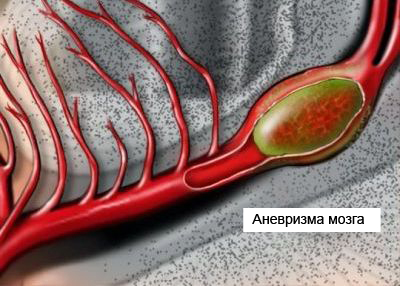Aneurysm mozga – occlusion of a brain aneurysm
Description occlusion of a brain aneurysm
Occlusion brain aneurysm is to install clamps on the artery, leading to the aneurysm, which prevents her bleeding and rupture. Sometimes held bypass – redirect incoming flow of the blood vessels to healthy areas of the brain. Usually, surgery is performed open-pit, what is done cephalotrypesis.

Indications for occlusion of a brain aneurysm
Microvascular occlusion often done to treat a brain aneurysm rupture, that damages arteries.
The operation will not restore the already damaged parts of the brain, but it will help stop the bleeding or to prevent aneurysm rupture.
Possible complications of a brain aneurysm occlusion
If you plan to occlusion of the aneurysm, you need to know about possible complications, which may include:
- Weakness;
- Numbness or tingling;
- Speech disorders;
- Changes in vision;
- Confusion, memory loss;
- Seizures;
- Infection;
- Reaction to anesthesia (eg, dizziness, lowering blood pressure, breathlessness);
- Renal;
- The formation of blood clots (possible stroke);
- Aneurysm rupture during surgery.
Factors, that may increase the risk of complications include:
- Smoking;
- Obesity;
- High blood pressure.
We need to discuss these risks with your doctor before surgery.
How is the occlusion of a brain aneurysm?
Preparation for the procedure (when elective surgery)
Before operations are carried out:
- Medical checkup, blood tests and tests using medical imaging techniques;
- Screening for allergies;
- Revision of the list of drugs taken, including prescription and non-prescription dietary supplements;
- Screening for disease or other disorders;
- Determination of risks and benefits of surgery.
On the eve of the operation:
- Before the operation to take pictures of the brain (used ultrasound, CT, MRT or angiography);
- It is necessary to organize the return home from the hospital;
- Do not eat or drink anything the night before surgery;
- Consult your doctor about the drugs taken. A week before surgery you may be asked to stop taking certain drugs: aspirin, non-steroidal anti-inflammatory drugs (NSAIDs) or blood thinners.
Anesthesia
Used general anesthesia, which blocks the pain and the patient support in a sleep state during operation. Is inserted through the venous catheter in the arm or hand.
Procedure brain aneurysm occlusion
In the operating room nurse sensor is connected, to control blood pressure, heart rate and pulse. It is introduced catheter urine collection during surgery.
The arm will be put a catheter to deliver a sedative and anesthetic. Nurse shave off the hair on the head in the area of operations.
A doctor holds craniotomy – removal of a small portion of the skull, to get access to the brain. Using x-rays and examination with a microscope, doctor is weakened portion of the vessel and imposes on him the clip, stopping the blood supply to the aneurysm. Also, the procedure can be performed bypass surgery (rerouting blood vessels, switching them to healthy areas of the brain).
Separation of part of the skull is placed on the place, the skin on the head is sewn.
Immediately after treatment of brain aneurysm occlusion
When the transaction is completed, the catheter and IV line will be removed. You will need to lie still for 6-8 hours or more. You will stay in the intensive care unit for about a day. Will monitor blood pressure and other vital parameters.
How long will the occlusion of a brain aneurysm?
3-5 hours or more.
Occlusion of brain aneurysm – Will it hurt?
You can feel the pressure, when introduced venous catheter for anesthesia. Anesthesia prevents pain during surgery. Pain or soreness after the procedure are removed with the help of painkillers.
The average time of stay in the hospital after a brain aneurysm occlusion
The operation is performed in a hospital. Usually the duration of stay of 4-6 days. The doctor can extend the period of stay, If there are complications.
Care after occlusion of a brain aneurysm
In the hospital
- You have a few hours after the operation is in the ICU;
- A nurse will monitor vital signs.
Home Care
Recovery will take at least 3-6 weeks. When you return home, Follow these steps:, to ensure the normal recovery:
- Get plenty of rest;
- Control your blood pressure;
- Clean Operating incision, as indicated by a physician. Use a soft cloth to gently wipe the incision area and keep it in dry;
- Take prescribed medications;
- Take part in rehabilitation activities;
- Ask the doctor, when it is safe to shower, bathe, or to expose the surgical site to water.
Be sure to follow all instructions from your doctor.
Contact your doctor after occlusion of a brain aneurysm
After discharge from the hospital need to see a doctor, If the following symptoms:
- Any changes in physical ability – of force, motion, coordination;
- Changes in mental status – level of consciousness, memory, thinking or reactions;
- Weakness, numbness, pricking;
- Signs of infection, including fever and chills;
- Redness, edema, strong pain, bleeding or discharge from the incision;
- Lingering headache;
- Changes in vision;
- Fainting;
- Pain, which does not pass after taking pain medication appointed;
- Nausea and / or vomiting, which do not disappear after taking the prescribed medicines, and persist for more than two days after discharge from the hospital;
- Problems control bladder and / or bowel.
Immediately call an ambulance for any of the following symptoms:
- Convulsions;
- Shortness of breath or chest pain;
- Loss of consciousness.
